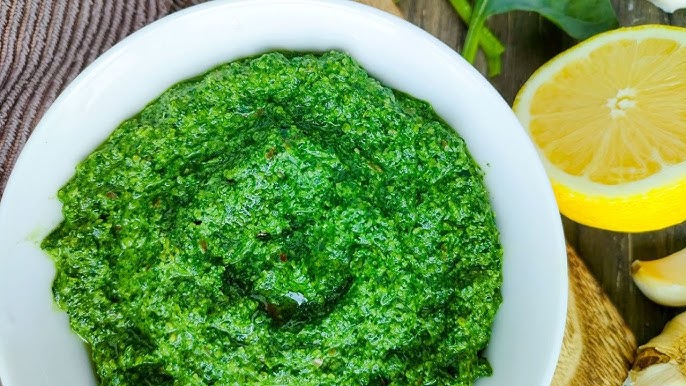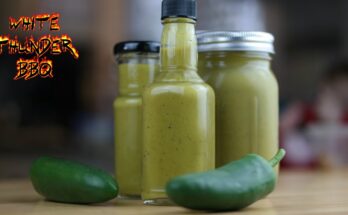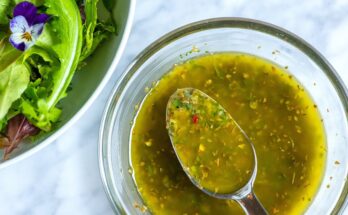Pesto Recipe: Who doesn’t love a good pesto? Pesto is one of those sauces that can elevate almost any dish with its rich, herby flavor. But what exactly is pesto, and why should you make it at home? In its simplest form, pesto is a blend of basil, olive oil, Parmesan cheese, pine nuts, and garlic. It’s traditionally made using a mortar and pestle (hence the name “pesto,” which means to pound), but modern kitchen tools like food processors make it quick and easy to whip up a fresh batch in minutes.
The Origins of Pesto
Pesto originated in Genoa, Italy, in the region of Liguria. It’s believed to have been around since Roman times, though the classic version we know today—Pesto alla Genovese—dates back to at least the 19th century. The traditional method calls for the ingredients to be ground slowly in a mortar, allowing the flavors to meld in a way that can be difficult to replicate with modern appliances. But don’t worry, even with a food processor, you can still achieve that signature deliciousness!
Why You Should Make Homemade Pesto
Sure, you can buy pesto at the store, but homemade pesto is so much better. It’s fresher, bursting with flavor, and you can tweak it to your liking. Plus, it’s surprisingly easy to make! Once you learn the basic recipe, you can adapt it with different ingredients for endless variations.
Ingredients for a Classic Pesto
For a traditional pesto, you’ll need just a handful of fresh ingredients:
- Fresh Basil Leaves: The star of the show. Look for bright green, fragrant leaves.
- Extra Virgin Olive Oil: Adds richness and helps blend the ingredients.
- Parmesan Cheese: Aged Parmesan or Pecorino Romano works best for that savory umami flavor.
- Pine Nuts: These add a creamy, buttery texture to the pesto.
- Garlic: A clove or two will add just the right amount of bite.
- Salt and Pepper: Simple seasonings to balance everything out.
You can also add optional ingredients like lemon zest or juice for brightness or swap out the pine nuts for walnuts or almonds to experiment with different flavors.
Tools You’ll Need
Before you get started, make sure you have the right tools. Traditionally, pesto is made with a mortar and pestle, but if you’re short on time or energy, a food processor will do the trick. You’ll also need a spatula, measuring cups and spoons, and a grater for the Parmesan.
Step 1: Preparing the Ingredients
To make the best pesto, you’ll need to prepare your ingredients thoughtfully:
- Choosing Fresh Basil: The fresher, the better. Avoid basil that looks wilted or has black spots.
- Toasting Pine Nuts: Toasting the pine nuts for a few minutes in a dry pan brings out a deeper, nuttier flavor.
- Grating Parmesan Cheese: Always use freshly grated Parmesan for the best texture and taste.
- Peeling Garlic: One or two cloves should be enough, but you can adjust according to your preference.
Step 2: Blending the Ingredients
There are two main methods for blending pesto: the traditional mortar and pestle or the modern food processor.
- Mortar and Pestle: If you want to be authentic, crush the garlic with a little salt first, then slowly add in the basil leaves. This method creates a more rustic texture, but it takes some elbow grease.
- Food Processor: For a quicker version, add the garlic and pine nuts first, pulsing until finely chopped. Then add the basil, cheese, and a drizzle of olive oil. Pulse until combined.
Step 3: Adjusting the Consistency
Pesto should be smooth but still have some texture. If it’s too thick, slowly add more olive oil until it reaches your desired consistency. If it’s too thin, add a few more basil leaves or pine nuts to thicken it up.
Step 4: Seasoning and Tasting
Taste your pesto before calling it done. Adjust the salt and pepper as needed, keeping in mind that the Parmesan is salty, so start with less and build up. Taste for balance—no single ingredient should overpower the others.
Step 5: Storing Your Pesto
Once your pesto is ready, store it in an airtight container. Pour a thin layer of olive oil on top to prevent it from oxidizing and turning brown. You can keep it in the fridge for about a week, or freeze it in small portions for up to three months.
Step 6: Serving Suggestions
Pesto isn’t just for pasta! While it’s a classic pairing, you can also:
- Spread it on sandwiches or wraps.
- Stir it into soups for a burst of flavor.
- Use it as a dip or drizzle over roasted veggies.
Variations on the Classic Pesto Recipe
Once you’ve mastered the basics, feel free to experiment:
- Sun-Dried Tomato Pesto: Swap out some of the basil for sun-dried tomatoes.
- Spinach and Walnut Pesto: A heartier, earthier version using spinach and walnuts.
- Arugula Pesto: For a peppery twist, replace the basil with fresh arugula.
Tips for the Perfect Pesto
- Balance Flavors: Too much garlic can overpower the sauce. Use just enough to add a hint of sharpness.
- Texture Matters: Don’t over-process the pesto in a food processor. Aim for a slightly chunky consistency.
- Dairy-Free Pesto: Simply omit the Parmesan or replace it with nutritional yeast for a vegan version.
Common Mistakes to Avoid
- Over-Blending: This can cause the pesto to become too smooth and lose its vibrant color.
- Too Much Garlic: A little goes a long way; too much can overwhelm the basil.
- Skipping Toasting the Nuts: Toasting adds depth, and it only takes a few minutes!
Health Benefits of Pesto
Pesto is not only delicious but also packed with health benefits. Basil is rich in antioxidants, and olive oil provides healthy fats. Pine nuts add protein, while Parmesan brings calcium and vitamin D.
FAQs about Pesto Recipe
What is pesto?
Pesto is a classic Italian sauce made from fresh basil, garlic, pine nuts, Parmesan cheese, and olive oil. It has a rich, flavorful taste that enhances a variety of dishes.
Can I make pesto without pine nuts?
Yes, you can substitute pine nuts with other nuts like walnuts or almonds. The flavor will slightly differ, but the texture and overall taste will still be delicious.
How long does homemade pesto last?
Homemade pesto can last in the fridge for up to a week if stored in an airtight container. To extend its shelf life, you can freeze pesto for up to three months.
Can pesto be used in other dishes besides pasta?
Absolutely! Pesto is versatile and can be used as a spread on sandwiches, a marinade for meats, or a topping for roasted vegetables.
Is pesto gluten-free?
Yes, pesto is naturally gluten-free. However, always check the labels of store-bought pesto for any potential additives.
Can I make vegan pesto?
Yes, you can make vegan pesto by substituting the Parmesan cheese with nutritional yeast or a plant-based cheese alternative.
Conclusion
Making homemade pesto is not only easy but also incredibly rewarding. Whether you’re tossing it with pasta, spreading it on sandwiches, or using it as a dip, the fresh flavor of homemade pesto will always elevate your dishes. Plus, you can tweak the recipe to suit your preferences and dietary needs. So grab some fresh basil and get started!



